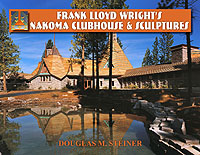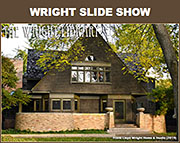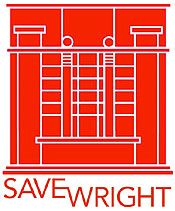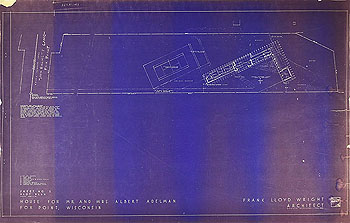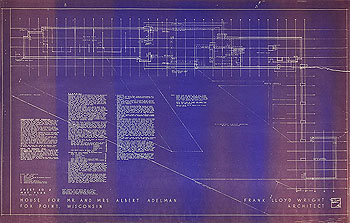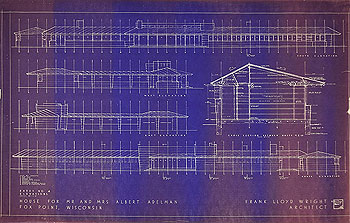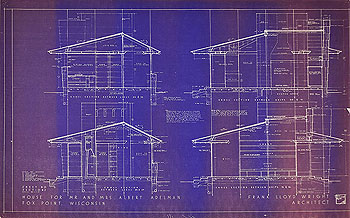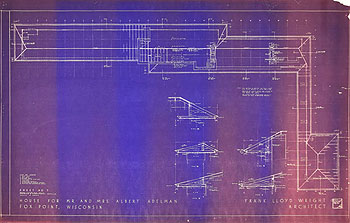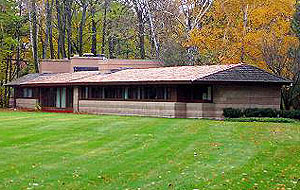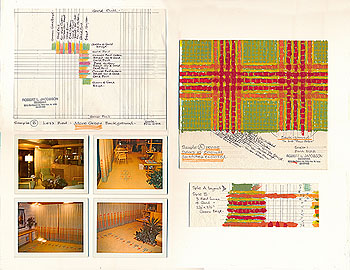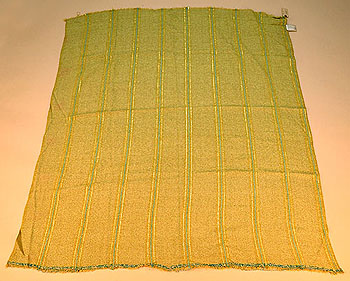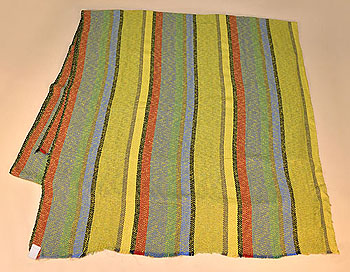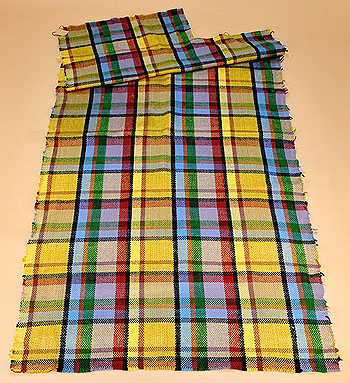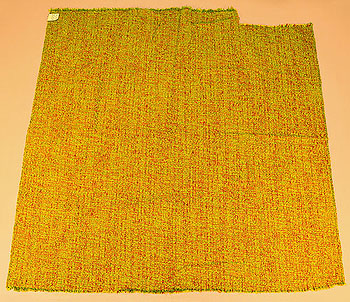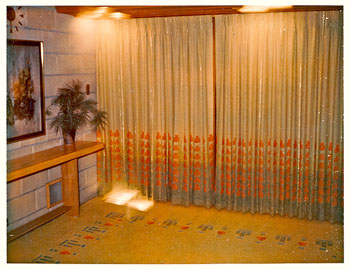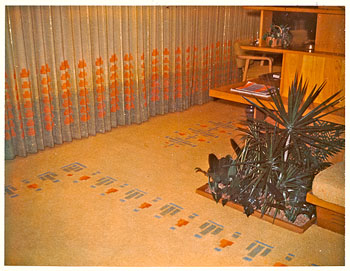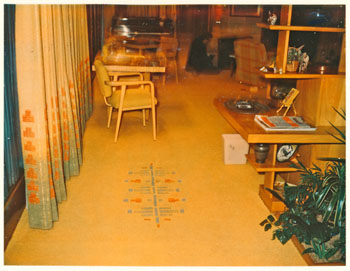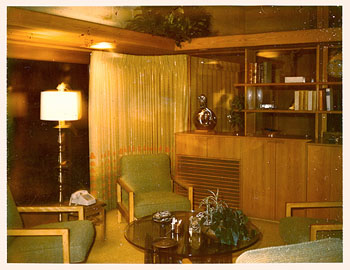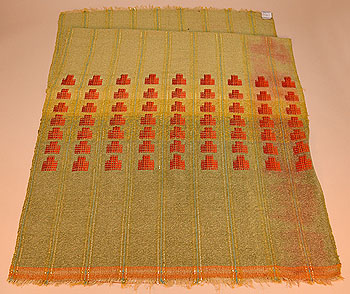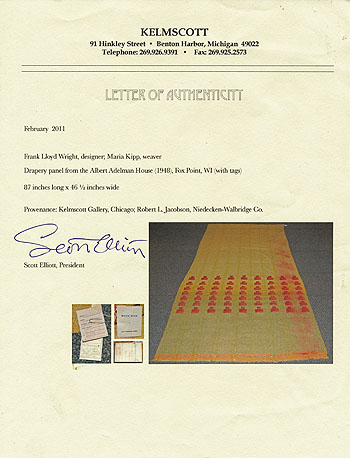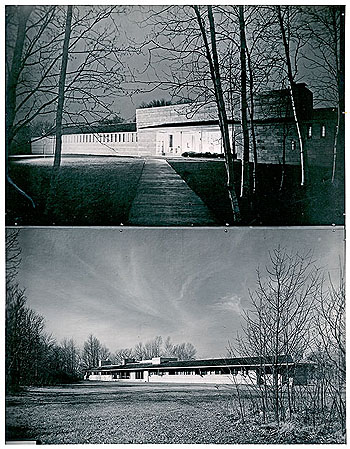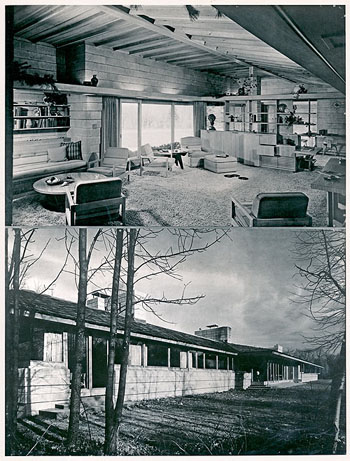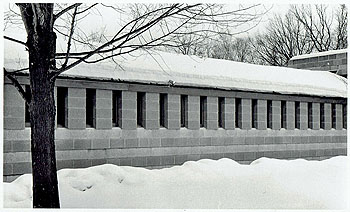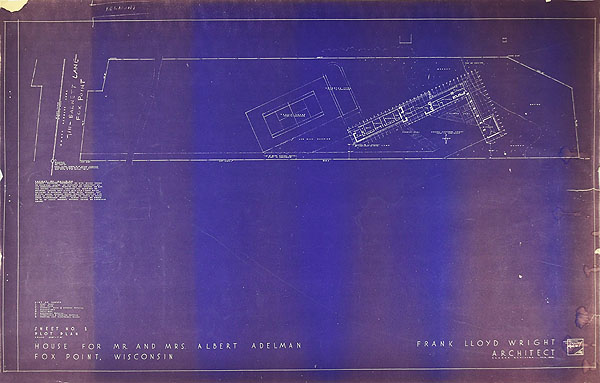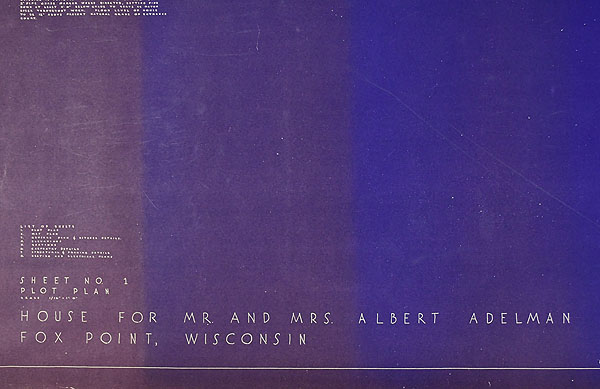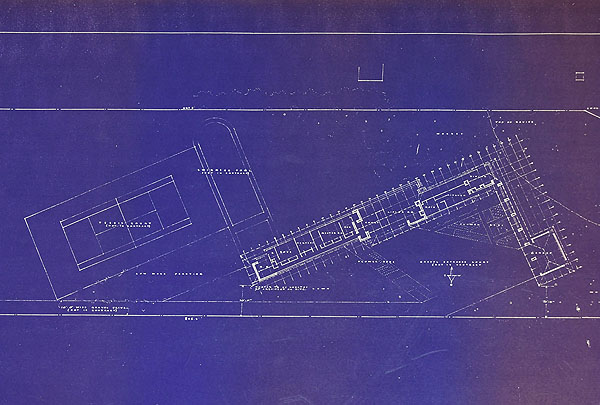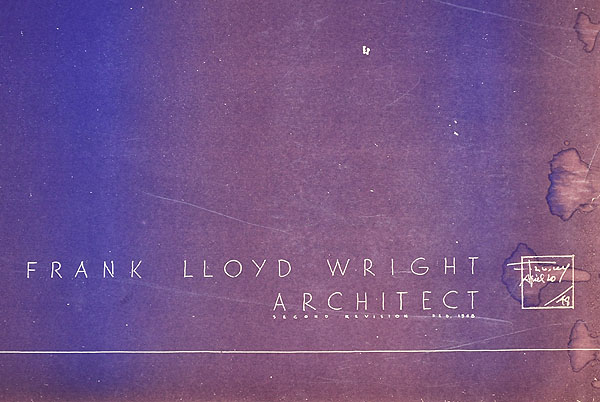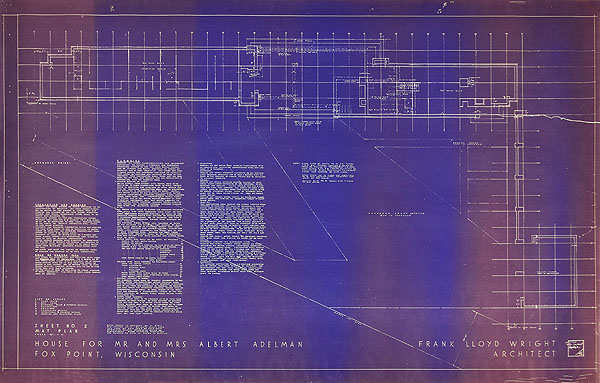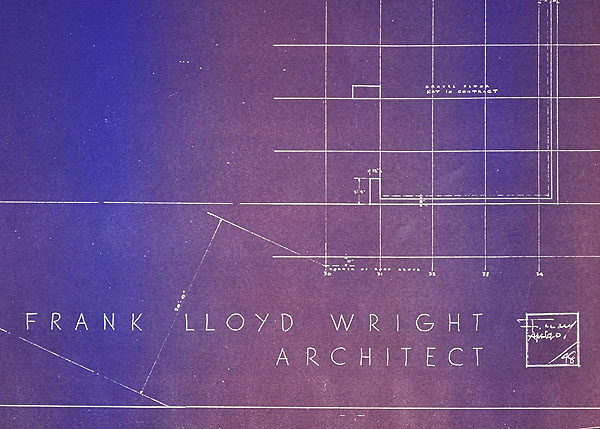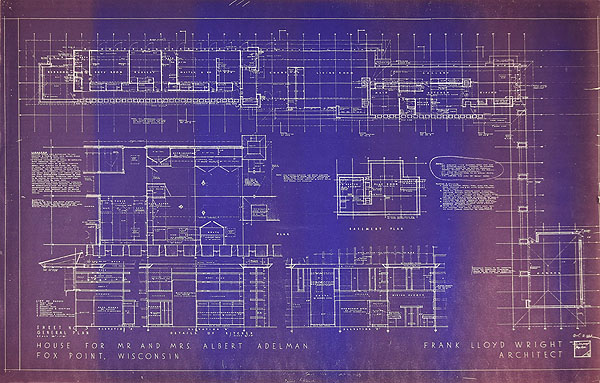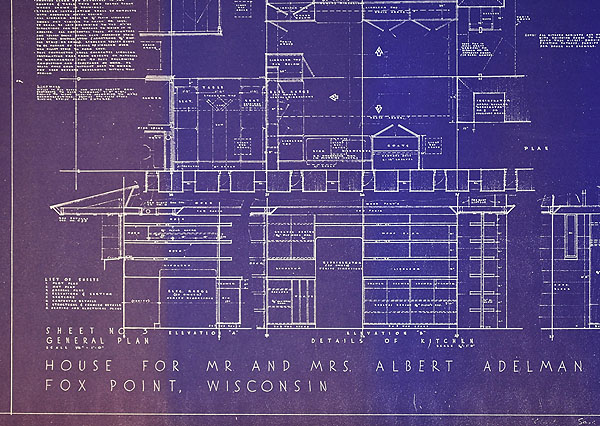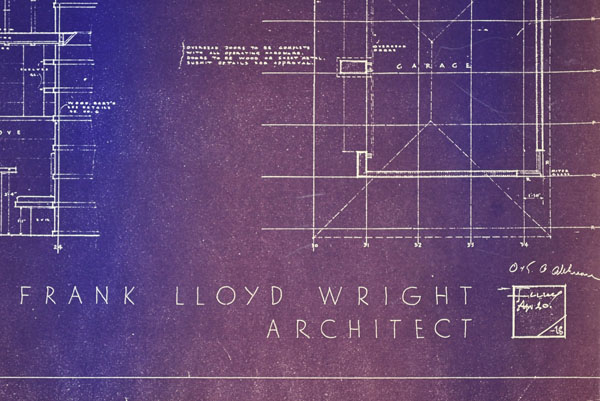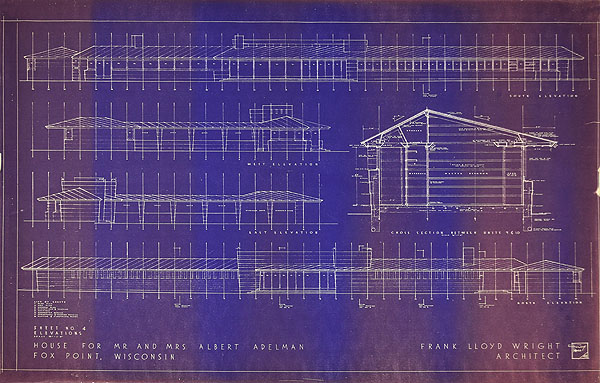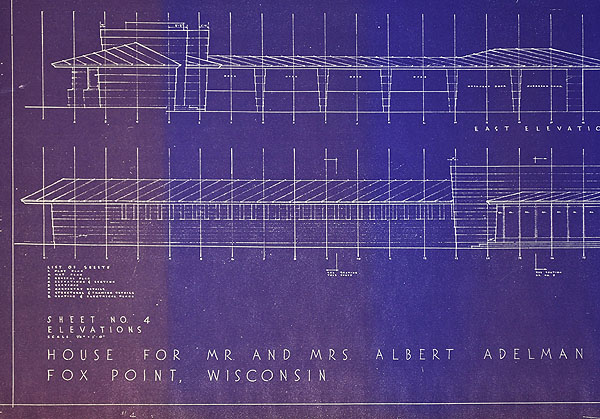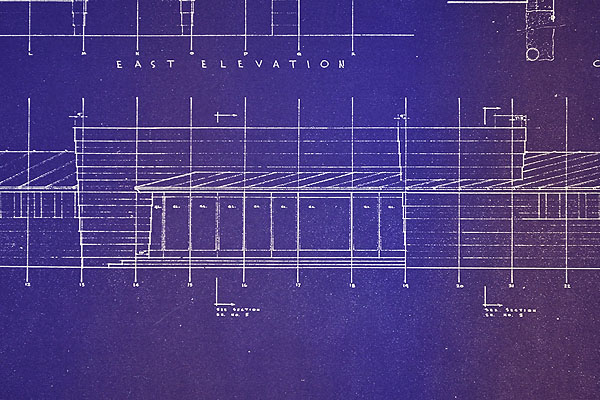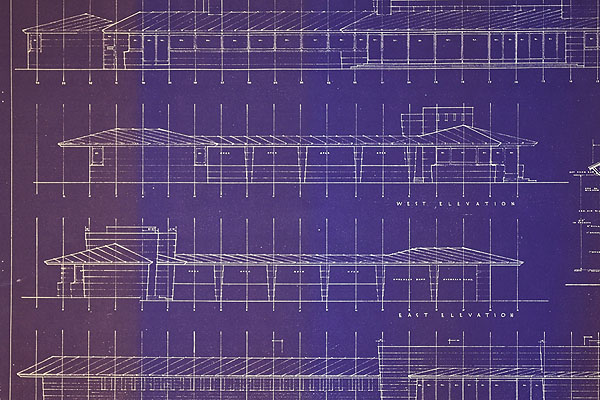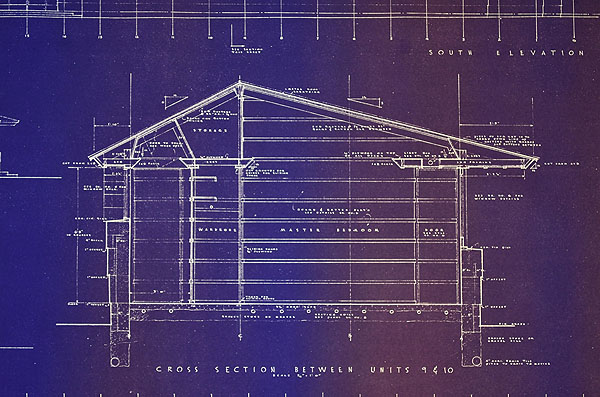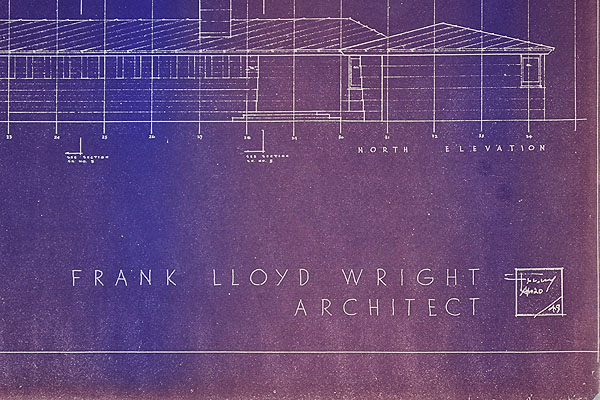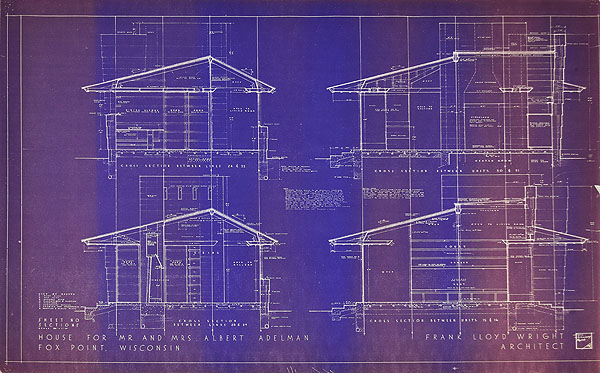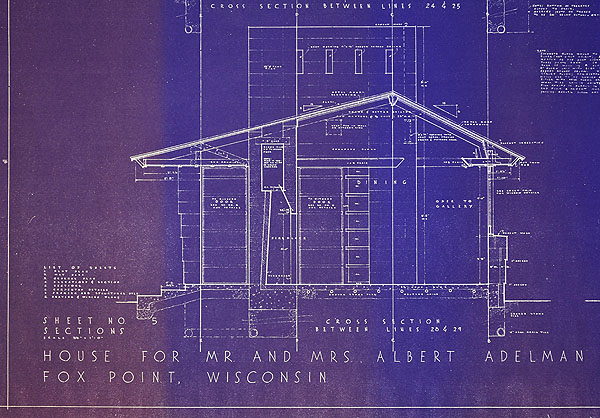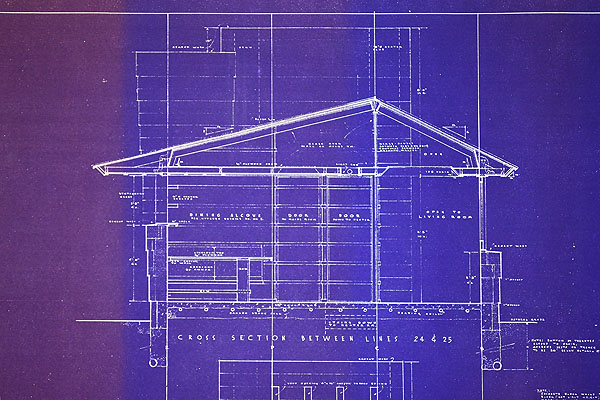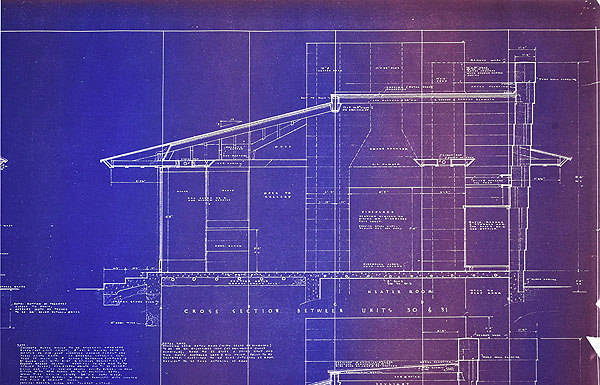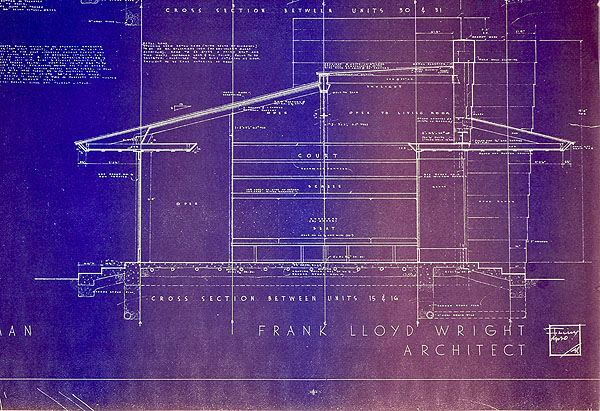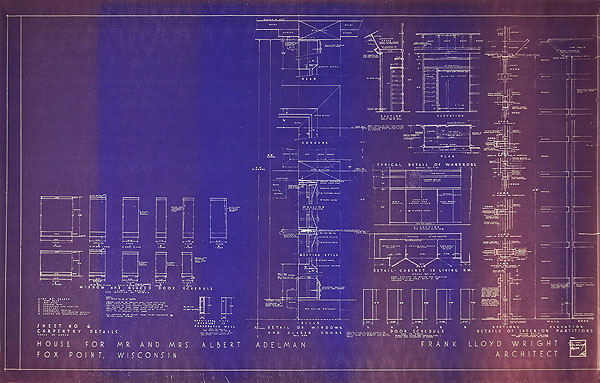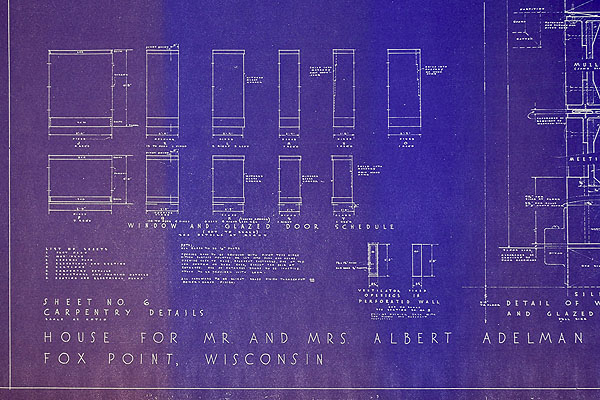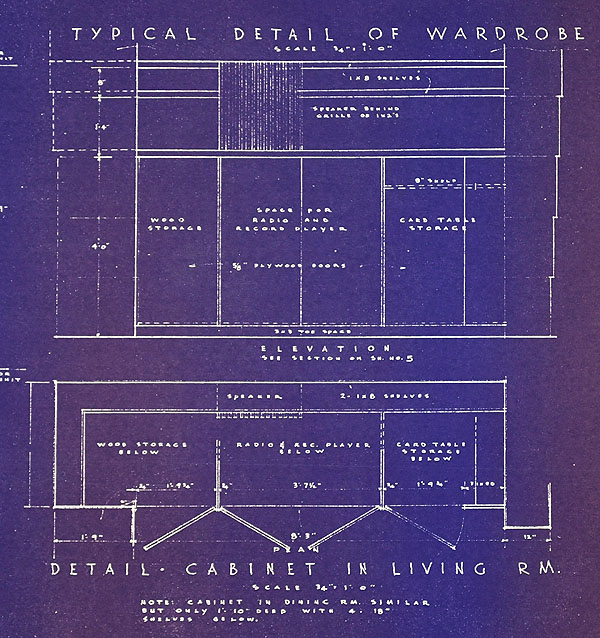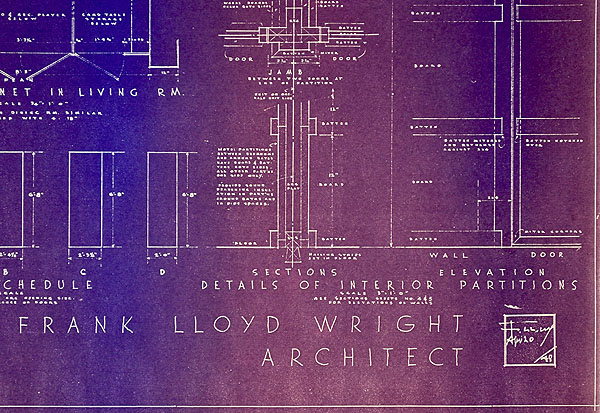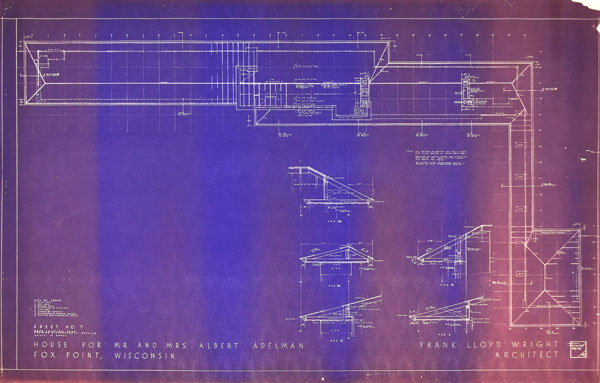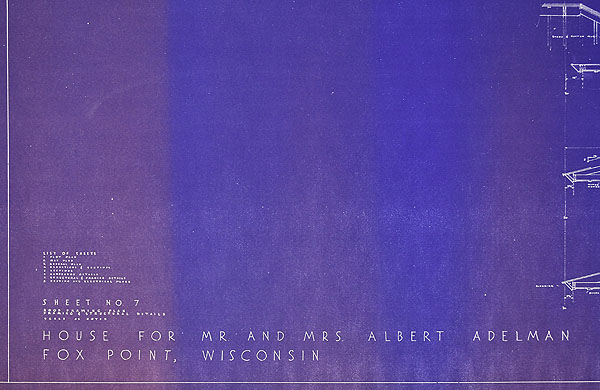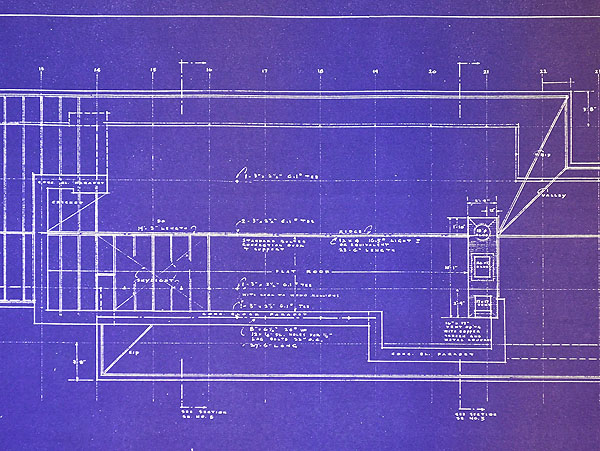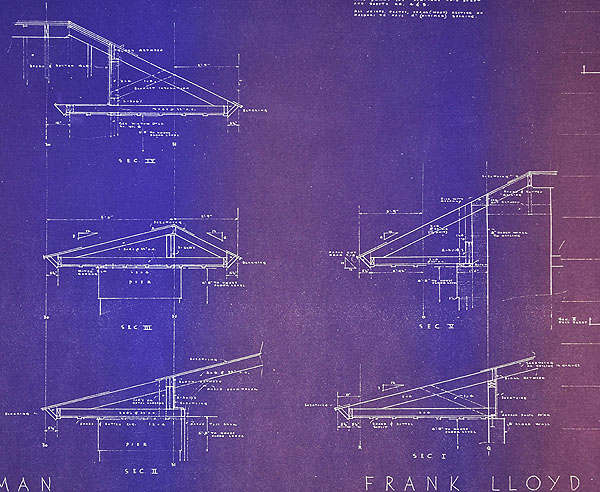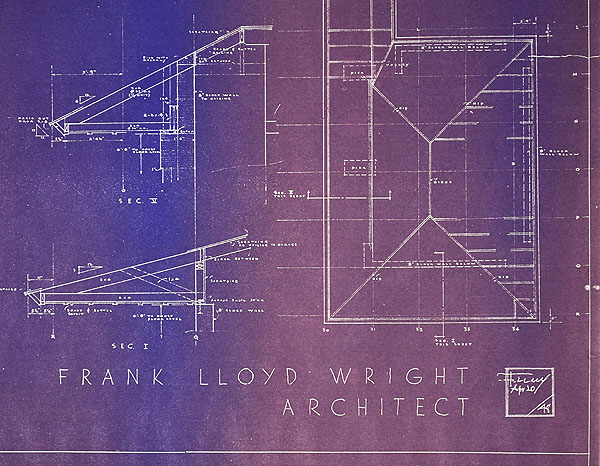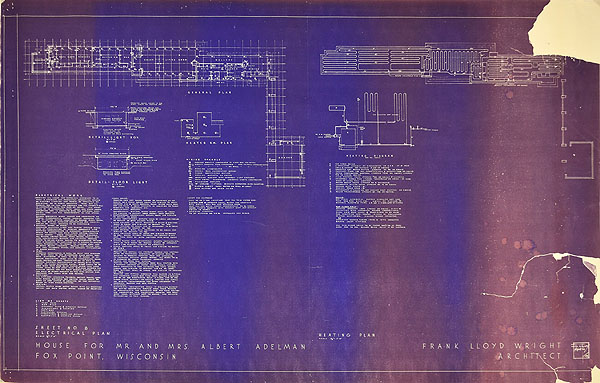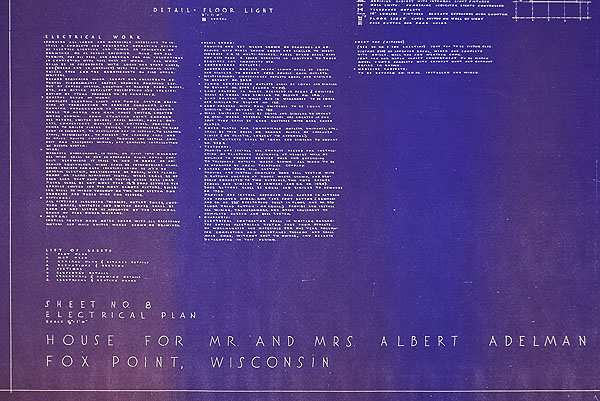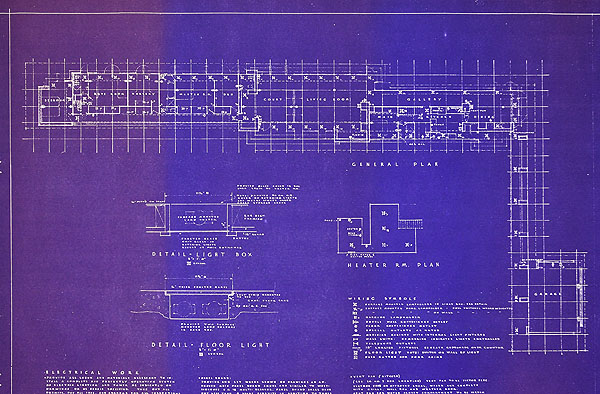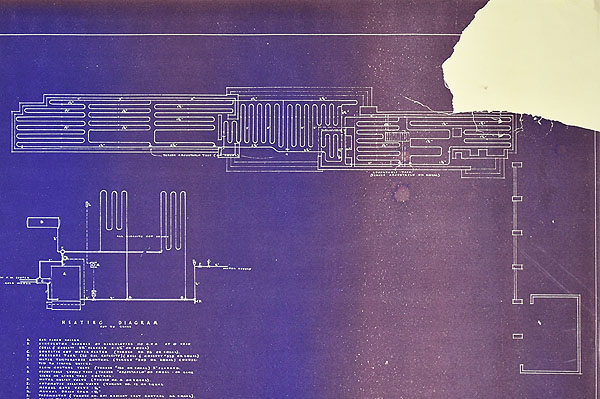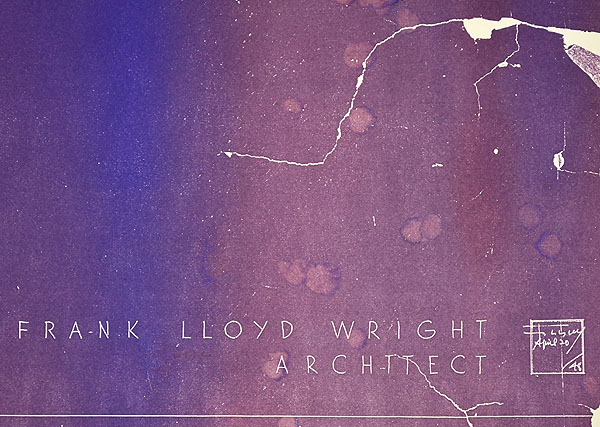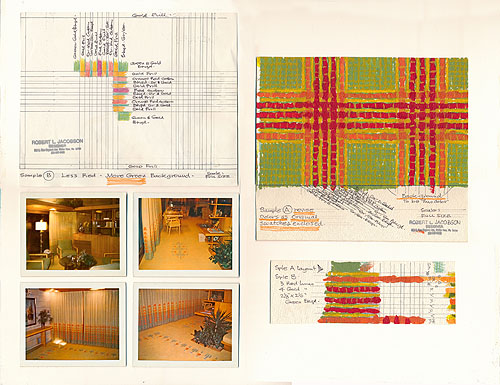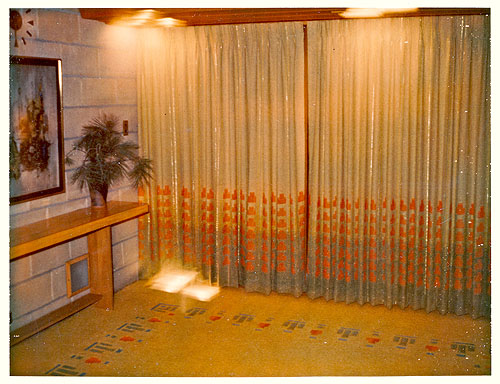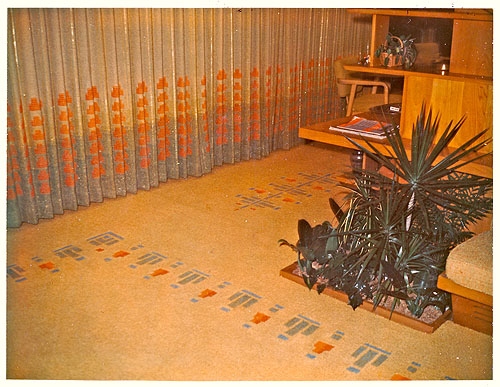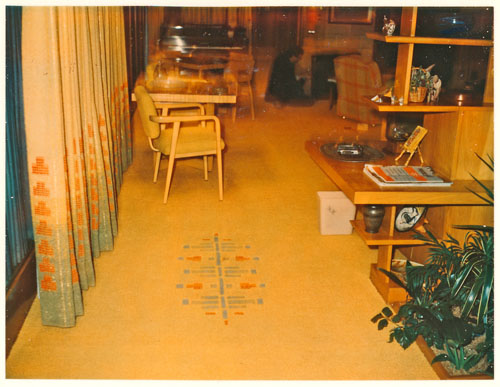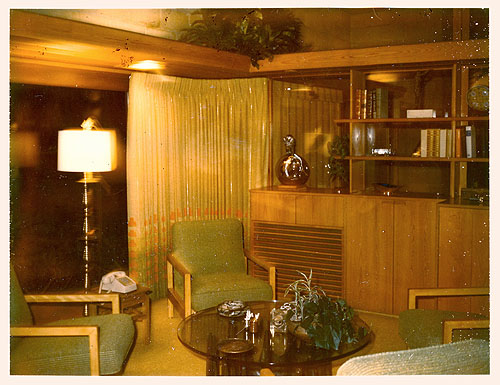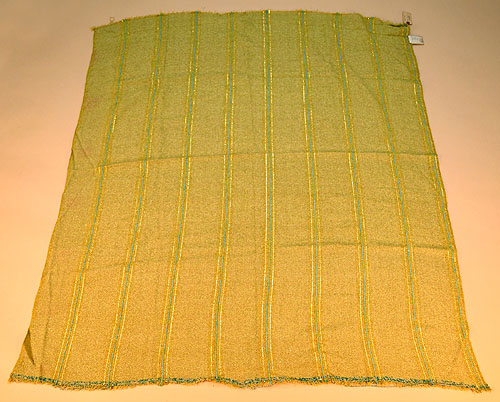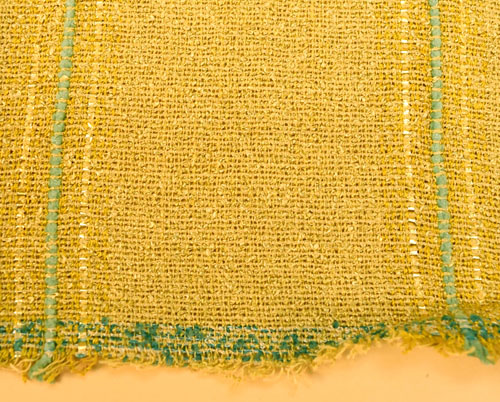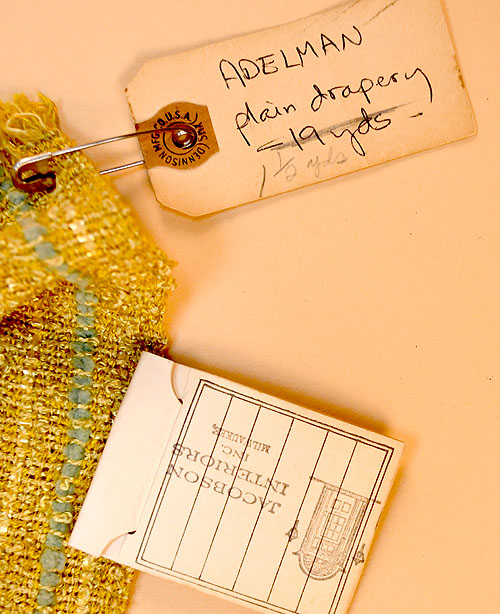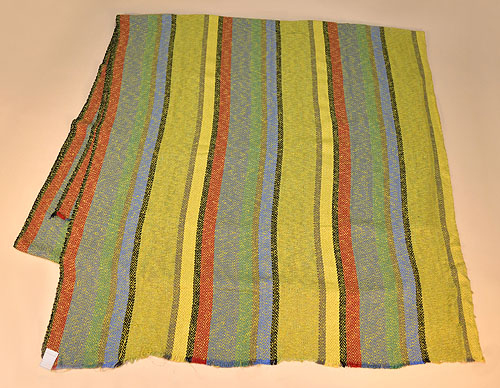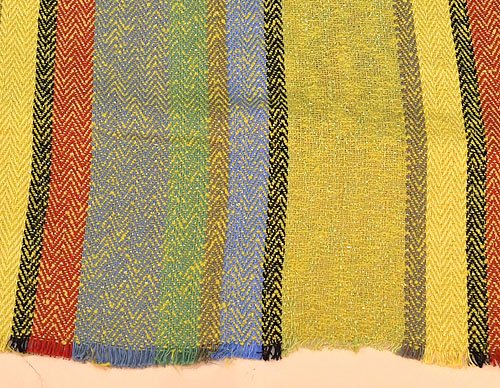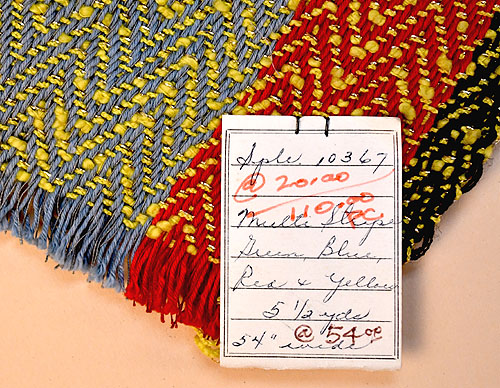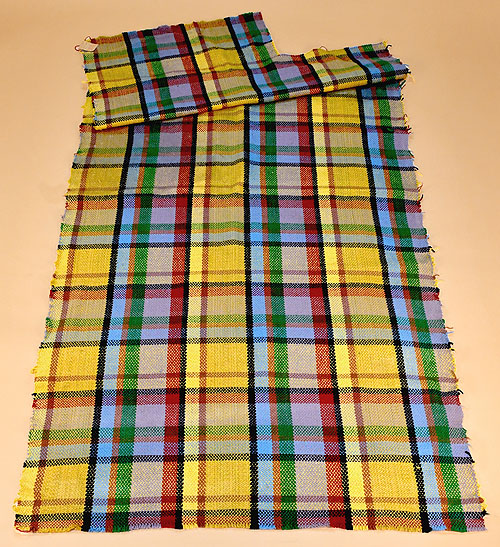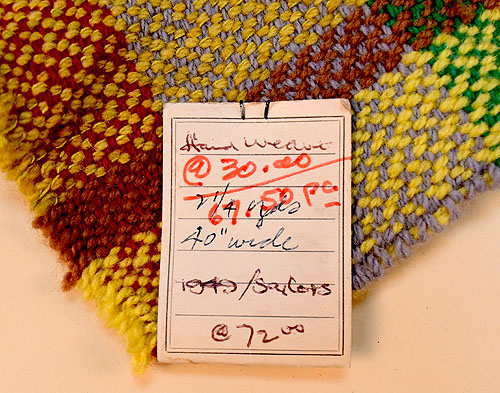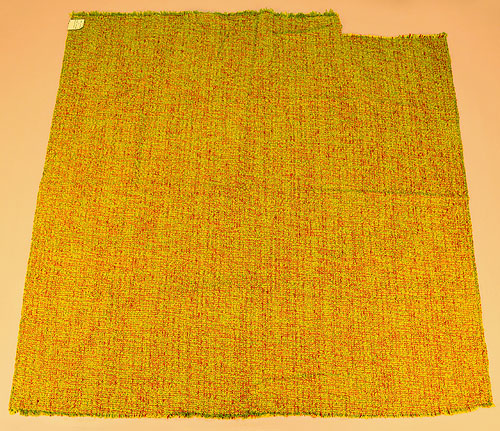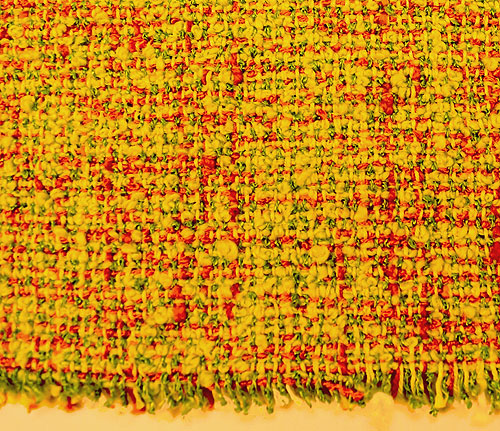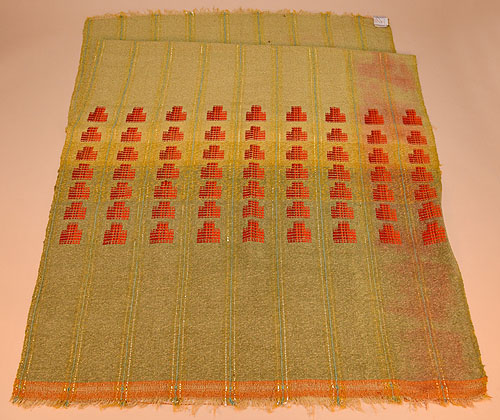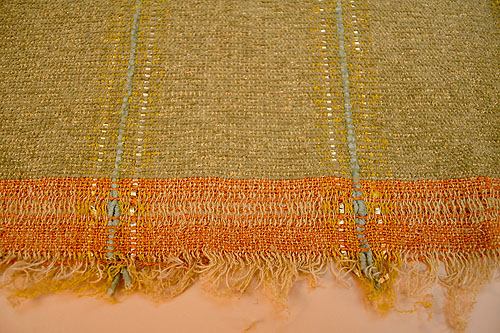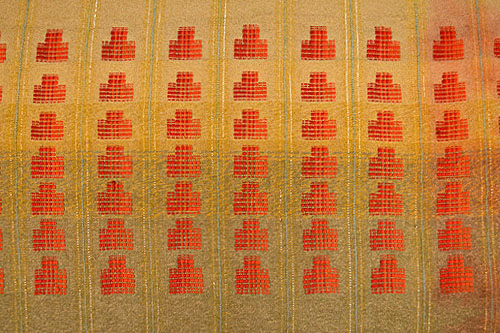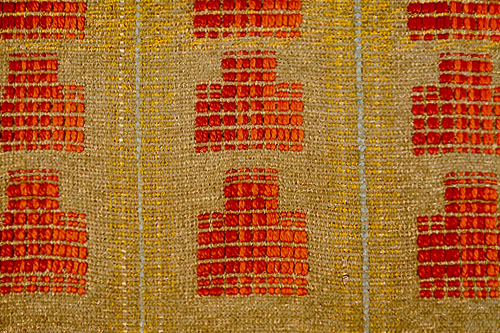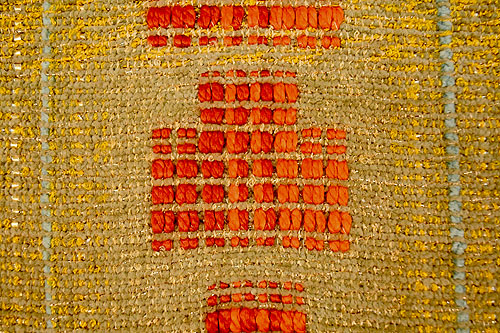
SUPPORT THE
WRIGHT LIBRARY
PROCEEDS FROM EVERY SALE GOES TO SUPPORT THE WRIGHT LIBRARY.
CLICK TO ORDER.
WE PROUDLY SUPPORT THE FRANK LLOYD WRIGHT FOUNDATION
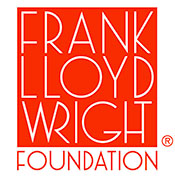
WE PROUDLY SUPPORT THE FRANK LLOYD WRIGHT BUILDING CONSERVANCY
WE PROUDLY SUPPORT FALLINGWATER
AND THE WESTERN PENNSYLVANIA CONSERVANCY

ALBERT ADELMAN HOUSE, FOX POINT, WISCONSIN (1948 - S.308) BLUEPRINTS SCHEME #2 (1948) DESIGN BOARD & FABRIC (1948) ADELMAN HOUSE DRAPES (1948)
BENJAMIN ADELMAN RESIDENCE (1951)Date: 1948
Title: Albert Adelman House, Fox Point, Wisconsin, 1948 Blueprints Scheme #2 (1948 - S.308).
Description: Set of eight blueprints for the Albert Adelman House. Frank Lloyd Wright’s first project for Adelman was in 1945, the Laundry Building for Adelman and Son. It remained an unrealized project. Wright next designed a house for Adelman in 1946, Scheme #1. Published in Frank Lloyd Wright, Monograph 1942-1950, Pfeiffer, 1990, p.124. Also published in Wright 1943-1959, Pfeiffer, 2009, p.80. Scheme #1 was rejected. Wright redesigned the house and it was published as Scheme #2, Frank Lloyd Wright, Monograph 1942-1950, Pfeiffer, 1990, p.125. Although Pfeiffer dates Scheme #2 as 1946, the published drawings are dated 1947 and appear to be the plans for Scheme #1. Pfeiffer corrects Scheme #2 in Wright 1943-1959, 2009, p.150. This set of eight plans are for Scheme #2. Plans are dated April 20, 1948. In the 1946 and 1947 plans, the house was "L" shaped. In this final... Continue...
See additional photographs...
See additional photographs...Date: 1948 Title: Albert Adelman House (1948), Fox Point, Wisconsin.
Date: 1948 Title: Original 1948 Frank Lloyd Wright design board and vintage fabrics for the Albert Adelman House (1948), Fox Point, WI.
Description: Original design board, four Polaroids and four fabrics for the Albert Adelman House. Designed by Frank Lloyd Wright in 1948.
Fabric 1: Drapery Fabric. Sample of the fabric used in the draperies before decorative elements were woven into the fabric. There are two tags attached to the fabric. The first tag is stamped: "Jacobson Interiors, Inc. Milwaukee." Hand written on the tag: "1 ½ Yds x 50 w." Second tag: "Adelman. Plain Drapery. 1 ½ yards." Robert L. Jacobson was the successor to George M. Niedecken. Niedecken was Wright's interior designer and decorator on many of his most famous commissions including the Dana House (1902), Springfield, IL, the Coonley House (1908), Riverside, IL and the Robie House (1909), Chicago, IL.
Size: 48" x 54." See finished drapery.
Fabric 2: Multi-Stripes. Colors include: Thick and thin Yellow, Olive and thin Copper, Gray, Light Olive, Black, Light and medium Blue, Thick and thin green, Red, Gold threads throughout. Hand written on tag: "Sple. 10367.Multi Stripe. Green, Blue, Red & Yellow. 5 ½ yds. 54" wide." 55 x 198".
Fabric 3: Hand weave. Colors include: Light Blue, Tan, Green, Gray, Dark Red, Yellow, Black, Olive, Gold threads throughout. Hand written on tag: "Hand weave. 2 1/4 yds. 40" wide. 1949/Sailors. Woven by Robert Sailor, the renowned American weaver who trained at the Cranbrook Academy, Bloomfield Hills, MI. 40" x 90."
Fabric 4: Multi-Color Texture. Colors include: Yellow, Green, Red. Hand written on tag: "Stle. 10540 x 50. Multi-Color Texture. B/u-5653-6048. Adelman Residence." This fabric appeared to be used on the built-in seating in the Entry Court (Photo 2). 52" x 52". See additional photographs...Size: Board and four pieces of material. 1) Drapery fabric, 48" x 54" 2) Multi-stripes, 55" x 198". 3) Hand weave, 40" x 90". 4) Multi-color Texture, 52" x 52". Design board: 20 x 16
S#: 0746.02.1104
Fabric 1: Drapery Fabric. Sample of the fabric used in the draperies before decorative elements were woven into the fabric. There are two tags attached to the fabric. The first tag is stamped: "Jacobson Interiors, Inc. Milwaukee." Hand written on the tag: "1 ½ Yds x 50 w." Second tag: "Adelman. Plain Drapery. 1 ½ yards." Robert L. Jacobson was the successor to George M. Niedecken. Niedecken was Wright's interior designer and decorator on many of his most famous commissions including the Dana House (1902), Springfield, IL, the Coonley House (1908), Riverside, IL and the Robie House (1909), Chicago, IL. 48" x 54." See finished drapery. (S#0746.02.1104 -5) See additional photographs...
Fabric 2: Multi-Stripes. Colors include: Thick and thin Yellow, Olive and thin Copper, Gray, Light Olive, Black, Light and medium Blue, Thick and thin green, Red, Gold threads throughout. Hand written on tag: "Sple. 10367.Multi Stripe. Green, Blue, Red & Yellow. 5 ½ yds. 54" wide." 55 x 198". (S#0746.02.1104 -6) See additional photographs...
Fabric 3: Hand weave. Colors include: Light Blue, Tan, Green, Gray, Dark Red, Yellow, Black, Olive, Gold threads throughout. Hand written on tag: "Hand weave. 2 1/4 yds. 40" wide. 1949/Sailors. Woven by Robert Sailor, the renowned American weaver who trained at the Cranbrook Academy, Bloomfield Hills, MI. 40" x 90." (S#0746.02.1104 -7) See additional photographs...
Fabric 4: Multi-Color Texture. Colors include: Yellow, Green, Red. Hand written on tag: "Stle. 10540 x 50. Multi-Color Texture. B/u-5653-6048. Adelman Residence." This fabric appeared to be used on the built-in seating in the Entry Court. 52" x 52". (S#0746.02.1104 -8) See additional photographs...Date: 1948
Title: Photo 1: Albert Adelman Residence, Fox Point, Wisconsin Design Board Polaroid 1948 (1948 - S.308).
Description: Copy photograph from original 4.24 x 3.5 color Polaroid. View of the Entry Court looking South from the Entrance. Built in wall table is on the left. Original drapes in the background cover floor to ceiling windows and doors. Carpet with matching design elements in the foreground. Scanned from the original Polaroid and enhanced by Douglas M. Steiner. See additional photographs...
Size: 10 x 8 Color photograph.
S#: 0746.02.1104 -1
Date: 1948
Title: Photo 2: Albert Adelman Residence, Fox Point, Wisconsin Design Board Polaroid 1948 (1948 - S.308).
Description: Copy photograph from original 4.24 x 3.5 color Polaroid. View of the Entry Court and Living Room looking Southwest. Original drapes in the background cover floor to ceiling windows and doors. Carpet with matching design elements in the foreground. Built in shelves ar3 to the right. Built-in seating to the far right. Scanned from the original Polaroid and enhanced by Douglas M. Steiner. See additional photographs...
Size: 10 x 8 Color photograph.
S#: 0746.02.1104 -2Date: 1948
Title: Photo 3: Albert Adelman Residence, Fox Point, Wisconsin Design Board Polaroid 1948 (1948 - S.308).
Description: Copy photograph from original 4.24 x 3.5 color Polaroid. View of the Living Room from the Entry Court looking West. Original drapes on the left cover floor to ceiling windows and doors. Carpet with matching design elements. Built in shelves are to the right. Scanned from the original Polaroid and enhanced by Douglas M. Steiner. See additional photographs...
Size: 10 x 8 Color photograph.
S#: 0746.02.1104 -3Date: 1948
Title: Photo 4: Albert Adelman Residence, Fox Point, Wisconsin Design Board Polaroid 1948 (1948 - S.308).
Description: Copy photograph from original 4.24 x 3.5 color Polaroid. View of the Northeast corner of the Living Room. The Entry is just behind the built-in cabinets. Original drapes in the background cover floor to ceiling windows and doors. Scanned from the original Polaroid and enhanced by Douglas M. Steiner. See additional photographs...
Size: 10 x 8 Color photograph.
S#: 0746.02.1104 -4Date: 1948
Title: Albert Adelman Residence, Fox Point, Wisconsin, Drapery Panel 1948 (1948 - S.308).
Description: Original hand-woven drapery panel for the Albert Adelman House, designed by Frank Lloyd Wright in 1948. Woven by Maria Kipp. Wool and gold metallic thread. Wright design for the Adelman family, this being the first completed Wright design. The drapes begin with the base fabric that is a light olive green. Every 5.5" a thick aqua green thread is woven vertically, the length of the material. One-half inches on either side of the aqua green is a wide gold "thread" that runs parallel and is approximately 3/32" wide. There are 9 sets of gold and aqua threads that run vertically. The bottom 29" transition to a dark olive. At first it appears that the top 68 inches have faded, but after examining it closely, the darker olive green is woven into the fabric. The threads are spaced out at first, then are threaded closer and closer until it is a solid dark olive, giving it a slow blended appearance. The red design elements are also woven into the cloth. Sewn in two colors, dark red on the left, a lighter shade of red on the right, and blended in the center. There are nine vertical rows and seven horizontal rows... Continue...
Size: 49" x 97"
S#: 0746.42.0821Date: 2011/1948
Title: Albert Adelman Residence, Fox Point, Wisconsin, Letter of Authenticity 2011 (1948 - S.308).
Description: Letter of Authenticity for original hand-woven drapery panel for the Albert Adelman House, designed by Frank Lloyd Wright in 1948. Woven by Maria Kipp. Text: "Kelmscott. Letter of Authenticity. February 2011. Frank Lloyd Wright\, designer; Maria Kipp, weaver. Drapery panel from the Albert Adelman House (1948), Fox Point, WI (with tags). 87 inches long x 46 ½ inches wide. Provenance: Kelmscott Gallery, Chicago; Robert L. Jacobson, Niedecken-Walbridge Co. Scott Elliott, President.
Size: 8.5 x 11
S#: 0746.42.0821-9Date: 1951
Title: Sixty Years of Living Architecture, Palazzo Strozzi, Florence, 1951.
Description: Display #102: "Adelmann House, Milwaukee, Wisc., 1949." Two views of the exterior. Upper is viewed from the North. Lower is viewed from the South. Part of a set of forty B&W photographs by Ancillotti & Co., of the exhibition "Sixty Years of Living Architecture" held in Florence, Italy, 1951. "Sixty Years of Living Architecture: The Work of Frank Lloyd Wright" was a traveling exhibition of Wright's work, consisting of models, large photographs and original drawings. A Preview of the exhibition was held in Philadelphia at Gimbel Brothers Gallery in January, 1951. The world wide tour opened in Palazzo Strozzi Florence, Italy in June, 1951. Ancillotti & Company photographed many of the models and also documented the large photographs that were on display.
Size: Original 9 x 7.25 B&W photograph.
S#: 0857.51.0221 -35Date: 1951
Title: Sixty Years of Living Architecture, Palazzo Strozzi, Florence, 1951.
Description: Display #102: "Adelmann House, Milwaukee, Wisc., 1949." Two views, interior and exterior. Upper view is of the living room. Lower is viewed from the West. Part of a set of forty B&W photographs by Ancillotti & Co., of the exhibition "Sixty Years of Living Architecture" held in Florence, Italy, 1951. "Sixty Years of Living Architecture: The Work of Frank Lloyd Wright" was a traveling exhibition of Wright's work, consisting of models, large photographs and original drawings. A Preview of the exhibition was held in Philadelphia at Gimbel Brothers Gallery in January, 1951. The world wide tour opened in Palazzo Strozzi Florence, Italy in June, 1951. Ancillotti & Company photographed many of the models and also documented the large photographs that were on display. The upper interior photograph of the living room is published in the Architectural Forum, January, 1951, Offprint, p.87.
Size: Original 9 x 7.25 B&W photograph.
S#: 0857.51.0221 -36Date: 1967
Title: Albert Adelman Residence, Fox Point, Wisconsin, 1967 (1948 - S.308).
Description: Designed by Frank Lloyd Wright in 1948. Frank Lloyd Wright modified his first design (Scheme 1), straightening out the "L", and removing the Library/Balcony and Sun Deck above the Living Room. Constructed of concrete block, cypress and cedar shakes. This was the first completed Wright design for the Adelman family. Frank Lloyd Wright designed a number of different projects for the Adelman family. Adelman Laundry Building (Project 1945), Albert Adelman House, Scheme #1 (Project 1946), Benjamin Adelman House (Project 1948), Albert Adelman Residence, Fox Point, Wisconsin (1948 - S.308). Benjamin Adelman House, Phoenix, AZ (1951 - S.344), Benjamin Adelman House, Whitefish Bay, Wisconsin. (Project 1954). Text handwritten on verso: "Adelman / Fox Pt." "1967." Also handwritten: "(Frank Lloyd Wright - Homes Designed By Him.)" Acquired from the archives of the Milwaukee Journal.
Size: Original 8 x 5 B&W photograph.
S#: 1720.74.0821ALBERT ADELMAN HOUSE BLUEPRINTS SCHEME #2 (1948)
Frank Lloyd Wright designed a number of different projects for the Adelman family. Adelman Laundry Building (Project 1945), Albert Adelman House, Scheme #1 (Project 1946), Benjamin Adelman House (Project 1948), Benjamin Adelman House, Phoenix, AZ (1951 - S.344), Benjamin Adelman House, Whitefish Bay, Wisconsin. (Project 1954).
Albert Adelman House, Fox Point, Wisconsin, 1948 Blueprints Scheme #2 (1948 - S.308). Set of eight blueprints for the Albert Adelman House. Frank Lloyd Wright’s first project for Adelman was in 1945, the Laundry Building for Adelman and Son. It remained an unrealized project. Wright next designed a house for Adelman in 1946, Scheme #1. Published in Frank Lloyd Wright, Monograph 1942-1950, Pfeiffer, 1990, p.124. Also published in Wright 1943-1959, Pfeiffer, 2009, p.80.Scheme #1 was rejected. Wright redesigned the house and it was published as Scheme #2, Frank Lloyd Wright, Monograph 1942-1950, Pfeiffer, 1990, p.125. Although Pfeiffer dates Scheme #2 as 1946, the published drawings are dated 1947 and appear to be the plans for Scheme #1. Pfeiffer corrects Scheme #2 in Wright 1943-1959, 2009, p.150. This set of eight plans are for Scheme #2. Plans are dated April 20, 1948. In the 1946 and 1947 plans, the house was "L" shaped. In this final 1948 version, the house has been elongated, and only the carport and garage are at a 90 degree angle. Wright also designed a home for Albert’s son Benjamin in 1948. In 1951 Wright designed a residence for his father Benjamin Adelman (S.344) in Phoenix, Arizona. Eight original blueprints. 33.5 x 52.5. (S#0746.38.022 1-8) ALBERT ADELMAN HOUSE DESIGN BOARD & FABRIC (1948)
Original design board, four Polaroids and four fabrics for the Albert Adelman House. Designed by Frank Lloyd Wright in 1948.
Fabric 1: Drapery Fabric. Sample of the fabric used in the draperies before decorative elements were woven into the fabric. There are two tags attached to the fabric. The first tag is stamped: "Jacobson Interiors, Inc. Milwaukee." Hand written on the tag: "1 ½ Yds x 50 w." Second tag: "Adelman. Plain Drapery. 1 ½ yards." Robert L. Jacobson was the successor to George M. Niedecken. Niedecken was Wright's interior designer and decorator on many of his most famous commissions including the Dana House (1902), Springfield, IL, the Coonley House (1908), Riverside, IL and the Robie House (1909), Chicago, IL. Size: 48" x 54." See finished drapery.
Fabric 2: Multi-Stripes. Colors include: Thick and thinYellow, Olive and thin Copper, Gray, Light Olive, Black, Light and medium Blue, Thick and thin green, Red, Gold threads throughout. Hand written on tag: "Sple. 10367.Multi Stripe. Green, Blue, Red & Yellow. 5 ½ yds. 54" wide." 55 x 198".
Fabric 3: Hand weave. Colors include: Light Blue, Tan, Green, Gray, Dark Red, Yellow, Black, Olive, Gold threads throughout. Hand written on tag: "Hand weave. 2 1/4 yds. 40" wide. 1949/Sailors. Woven by Robert Sailor, the renowned American weaver who trained at the Cranbrook Academy, Bloomfield Hills, MI. 40" x 90."
Fabric 4: Multi-Color Texture. Colors include: Yellow, Green, Red. Hand written on tag: "Stle. 10540 x 50. Multi-Color Texture. B/u-5653-6048. Adelman Residence." This fabric appeared to be used on the built-in seating in the Entry Court (Photo 2). 52" x 52".ALBERT ADELMAN HOUSE DRAPERY (1948)
Albert Adelman Residence, Fox Point, Wisconsin, Drapery Panel 1948 (1948 - S.308). Original hand-woven drapery panel for the Albert Adelman House, designed by Frank Lloyd Wright in 1948. Woven by Maria Kipp. Wool and gold metallic thread. Wright design for the Adelman family, this being the first completed Wright design. The drapes begin with the base fabric that is a light olive green. Every 5.5" a thick aqua green thread is woven vertically, the length of the material. One-half inches on either side of the aqua green is a wide gold "thread" that runs parallel and is approximately 3/32" wide. There are 9 sets of gold and aqua threads that run vertically. The bottom 29" transition to a dark olive. At first it appears that the top 68 inches have faded, but after examining it closely, the darker olive green is woven into the fabric. The threads are spaced out at first, then are threaded closer and closer until it is a solid dark olive, giving it a slow blended appearance. The red design elements are also woven into the cloth. Sewn in two colors, dark red on the left, a lighter shade of red on the right, and blended in the center. There are nine vertical rows and seven horizontal rows. The red design element is repeated in the carpet.
There are two tags attached to the drape. The first tag is stamped: "Jacobson Interiors, Inc. Milwaukee." Hand written on the tag: "4 Panels + customers’. Panel 95" L x 50" W." Robert L. Jacobson was the successor to George M. Niedecken.Niedecken was Wright’s interior designer and decorator on many of his most famous commissions including the Dana House (1902), Springfield, IL, the Coonley House (1908), Riverside, IL and the Robie House (1909), Chicago, IL.
Printed on the second tag: "Maria Kipp. Los Angeles, Calif." Hand written on verso: "13920-14755. 95" each. 4 panel + customers panel." Woven by Maria Kipp (1900-1988), German born designer and weaver. In 1924, she emigrated to the U.S. from Munich, where she had studied at the Kunstgewerbeschüle and the textile school in Muenchberg, Bavaria where she graduated as a textile engineer in 1923. After having her looms shipped to her Los Angeles CA location, she established a workshop and quickly gained commissions and a reputation for innovative hand-woven fabrics. She did custom designs for numerous decorators and architects, including Richard Neutra, Rudolph Schindler and Frank Lloyd Wright.
A pair of drapes sold at Wright Auctions, Chicago, on March 28, 2006 for $2160. A second pair was sold at Wright Auctions, Chicago, on March 25, 2007 for $4,500.
This piece is unhemmed and is in like new condition. Included with the drape is a "Letter of Authenticity" signed by Scott Elliott, Kelmscott Gallery. Provenance: Kelmscott Gallery, Chicago; Robert L. Jacobson. Dimensions are 97 in tall x 49 in wide.
HOME ARTIFACTS AUDIO BOOKS PERIODICALS PHOTOS POSTCARDS POSTERS STAMPS STUDIES ASSISTING ABOUT SLIDE SHOW To donate or pass on information, comments or questions:
steinerag@msn.com
©Copyright Douglas M. Steiner, 2001, 2025
